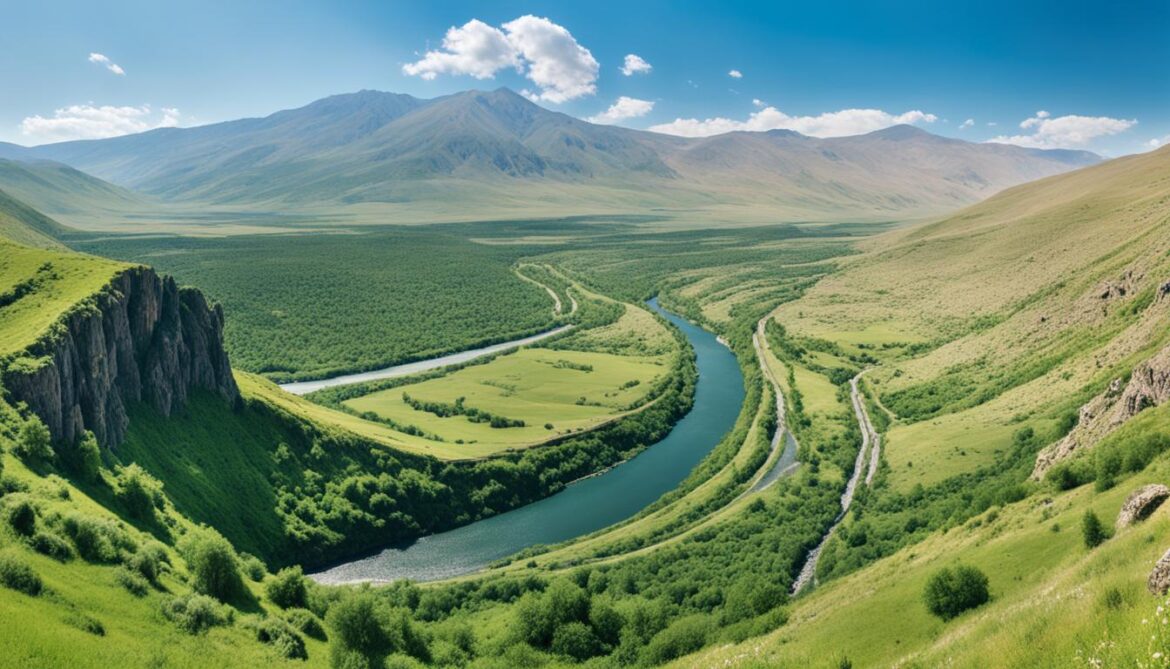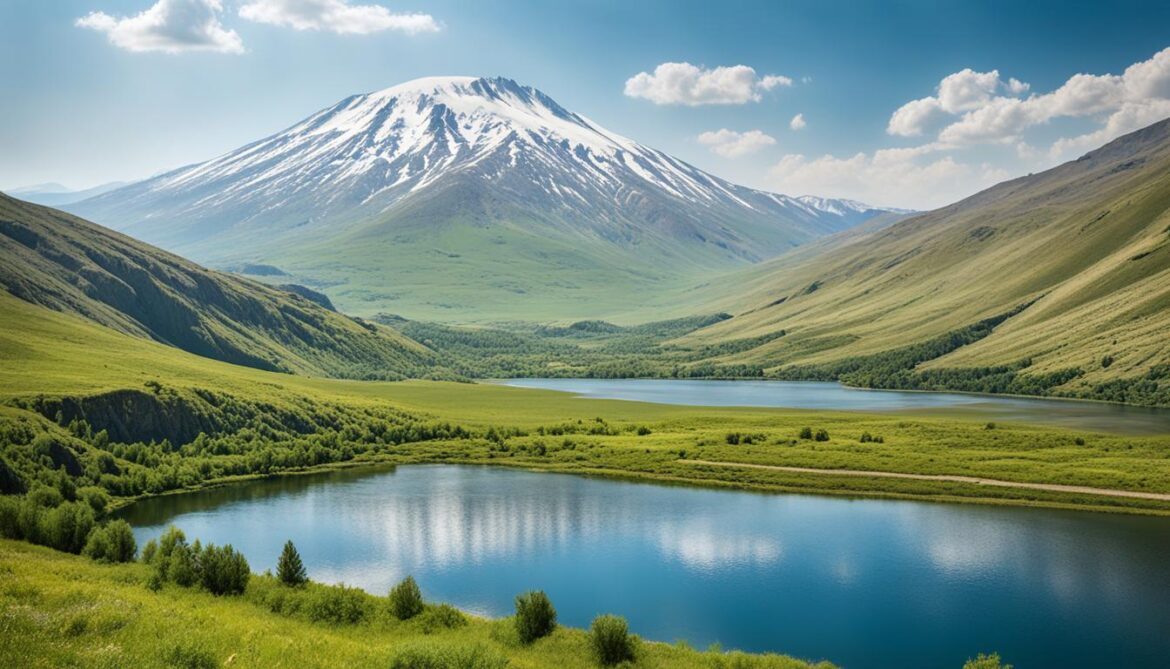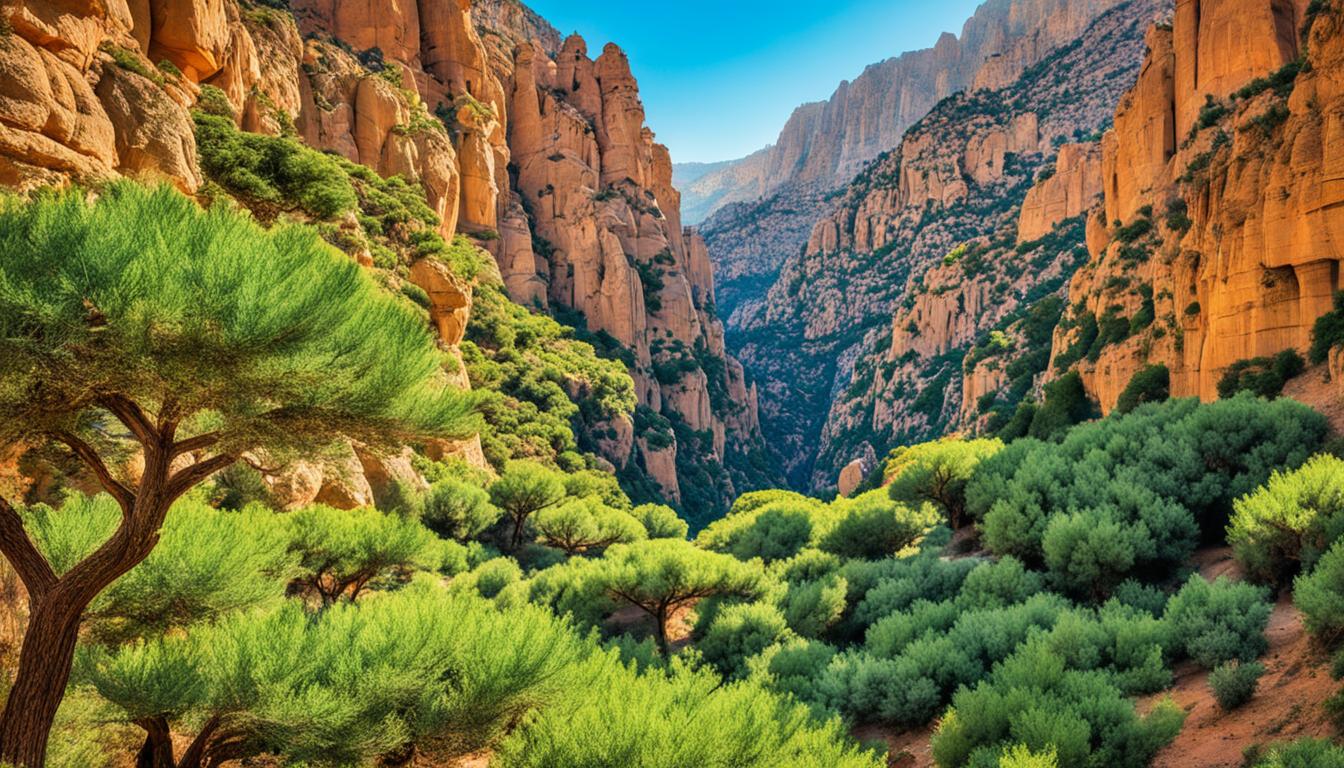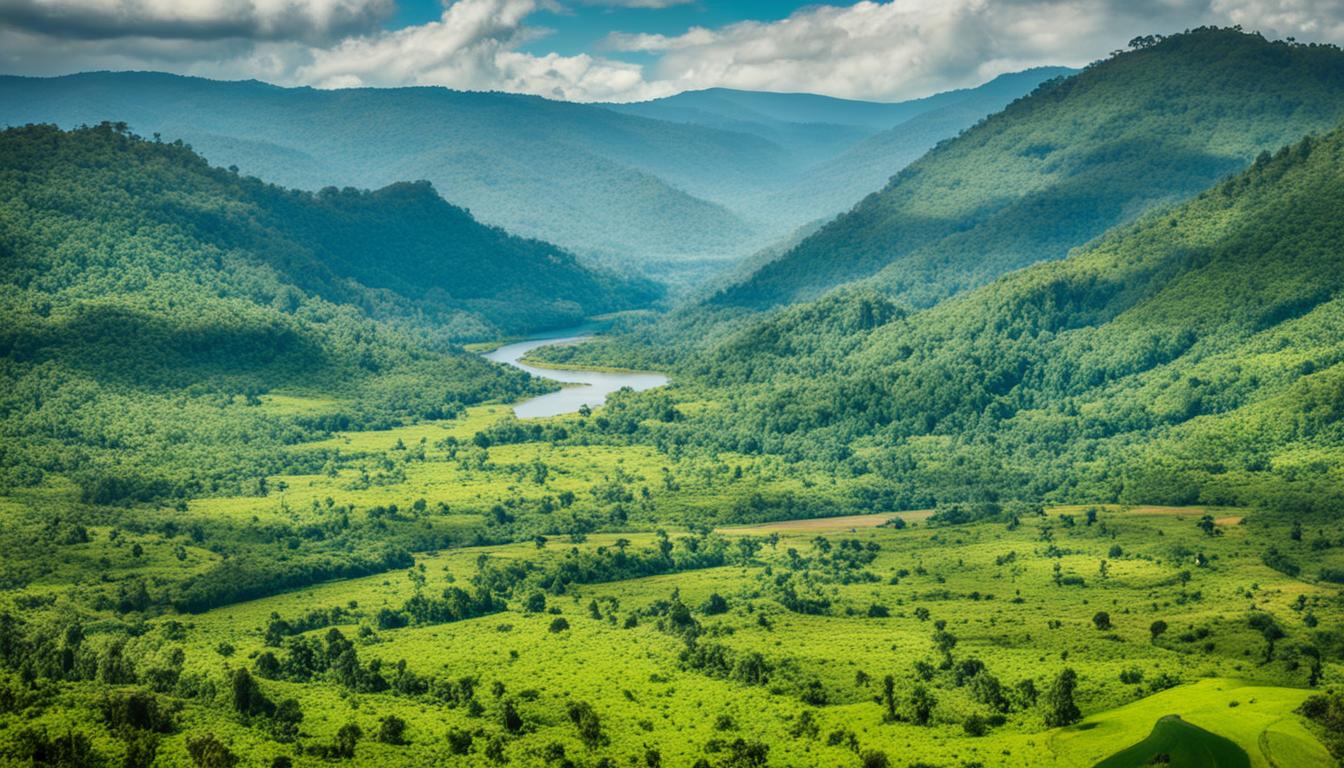Armenia Sacred Natural Sites and Biodiversity
Did you know that Armenia, a small country in the Caucasian region of Eurasia, is home to one of the planet’s most endangered biodiversity hotspots? This land of ancient traditions and breathtaking landscapes holds a natural heritage that is as diverse as it is sacred. From spiritual sites nestled in the mountains to rare and threatened species, Armenia’s nature conservation efforts play a vital role in preserving both its cultural and natural treasures.
Key Takeaways:
- Armenia is classified as one of the most endangered biodiversity hotspots on the planet.
- The country’s diverse landscapes are home to over 200 edible plant species, 40 edible fungi species, and more than 1000 fodder plants.
- Armenia’s flora includes many medicinal plants, with around 10% possessing medical properties.
- Efforts are being made to conserve and protect biodiversity through the establishment of specially protected areas and forest management plans.
- The Armenia Tree Project leads the reforestation efforts, aiming to double the country’s tree cover by 2050.
The Importance of Biodiversity in Armenia
Armenia is renowned for its breathtaking landscapes and rich biodiversity, which holds significant importance for the country’s economy, as well as its impact on agriculture, food production, and various industries. The diverse flora and fauna in Armenia’s ecosystems provide essential raw materials, contribute to recreational development, and support the overall well-being of the nation.
Forests, in particular, play a crucial role in maintaining biodiversity in Armenia. They not only provide a habitat for numerous plant and animal species but also offer valuable resources such as timber, non-timber forest products, and medicinal plants. Additionally, forests contribute to soil conservation, water regulation, and climate regulation, benefiting both the environment and society.
However, Armenia’s biodiversity is facing significant challenges. Human activities, including industrialization, agriculture, and urbanization, have resulted in habitat degradation, overexploitation, and pollution. These factors have led to the loss of biodiversity, jeopardizing the delicate balance of ecosystems and the survival of many species.
In response to this alarming trend, Armenia has taken proactive steps towards biodiversity conservation. The government has established specially protected areas, including national parks and nature reserves, to safeguard vulnerable habitats and species. These protected areas promote sustainable land use, limit human encroachment, and foster the recovery of threatened flora and fauna.
Furthermore, Armenia has developed forest management plans that aim to ensure the sustainable use of forests while preserving their ecological integrity. These plans focus on practices such as sustainable logging, reforestation, and the promotion of diverse tree species to enhance ecosystem resilience and maintain biodiversity.
“The conservation and protection of biodiversity in Armenia is not only crucial for safeguarding our natural heritage but also for preserving the environmental services that support our society. It is our responsibility to ensure the sustainability of our ecosystems for current and future generations.”
Efforts are also being made to raise public awareness about the importance of biodiversity conservation in Armenia. Educational initiatives, community involvement, and partnerships with NGOs and international organizations are integral to promoting a culture of environmental stewardship and sustainable development within the country.
The conservation of biodiversity in Armenia is a multifaceted challenge that requires continuous dedication and collaboration. By preserving and protecting the country’s rich natural heritage, Armenia can ensure the survival of its unique ecosystems, contribute to global biodiversity conservation efforts, and foster a sustainable future for both nature and humanity.
Armenia’s Sacred Natural Sites
Armenia is renowned for its sacred natural sites that hold immense cultural and spiritual significance for the Armenian people. These sites, often nestled in secluded and untouched areas such as mountains and forests, are considered sacred due to their remarkable beauty and deep connection with ancient traditions and beliefs. They serve as vital pillars in preserving Armenia’s rich cultural heritage and are celebrated as integral elements of the country’s natural legacy.
The sacred natural sites in Armenia represent a harmonious blend of spirituality and nature. These picturesque locations are not only admired for their awe-inspiring landscapes but also revered for their association with traditional nature beliefs that have been passed down through generations. The spiritual sites in Armenia offer individuals an opportunity for introspection, meditation, and spiritual renewal in the tranquil embrace of nature.
“These sacred natural sites hold the essence of our ancestral wisdom, reminding us of the profound interconnection between humanity and the natural world.”
Armenia’s sacred places epitomize the respect and reverence that the Armenian people have for the natural world. The unique beauty and enchanting ambiance of these sites evoke a deep sense of awe and wonder, inspiring visitors to contemplate their place within the grand tapestry of existence.
The Significance of Sacred Natural Sites
The spiritual sites in Armenia serve as reminders of the country’s enduring cultural identity and the ancient traditions deeply rooted in the collective consciousness of its people. These sacred natural sites provide a gateway for individuals to connect with their spiritual selves and foster a deep appreciation for the natural world and the intricate web of life.
Moreover, the traditional nature beliefs in Armenia encapsulate a holistic view of the environment, emphasizing the interconnectedness between humans and the natural world. The sacred places embody this belief system, serving as physical manifestations of the spiritual and cultural relationship that Armenians have with their surroundings.
“Armenia’s sacred natural sites are cherished as sacred spaces where the divine and natural realms converge, granting solace, inspiration, and a renewed sense of purpose.”
These sacred sites also play a vital role in conservation efforts in Armenia. By recognizing the cultural and spiritual significance of these locations, individuals and communities are motivated to protect and preserve the ecosystems and biodiversity that thrive within them. This holistic approach to conservation ensures the sustainability of Armenia’s natural heritage for future generations.

The Importance of Preserving Armenia’s Cultural Heritage
Preserving Armenia’s cultural heritage is of paramount importance, as it represents the soul of the nation and provides a link between past, present, and future generations. The sacred natural sites in Armenia stand as testament to the country’s rich history, ancient traditions, and profound connection with the natural world.
These sacred places not only inspire a sense of wonder and awe but also offer insights into the deep-rooted cultural and spiritual beliefs of the Armenian people. By protecting these sites, Armenia safeguards its cultural identity, fosters a sense of pride among its citizens, and showcases its unique heritage to the world.
| Key Features of Armenia’s Sacred Natural Sites | Contribution to Armenia’s Cultural Heritage |
|---|---|
| – Secluded and natural locations | – Preservation of ancient traditions and beliefs |
| – Unique beauty and enchanting landscapes | – Enhancing cultural identity and pride |
| – Spiritual significance and connection with nature | – Providing insights into Armenian spirituality |
| – Holistic approach to conservation | – Promoting environmental sustainability |
The preservation of Armenia’s sacred natural sites is a testament to the country’s commitment to safeguarding its cultural heritage and promoting sustainable practices. By cherishing and protecting these sacred places, Armenia ensures that its traditional nature beliefs and spiritual connections with the natural world continue to thrive, contributing to the country’s unique cultural fabric and enriching the lives of its people.
Conservation Efforts in Armenia
Armenia has taken significant actions to promote biodiversity conservation and environmental preservation throughout the country. Recognizing the importance of preserving its natural heritage, Armenia has developed a National Biodiversity Strategy and Action Plan. The plan outlines specific tasks and actions aimed at ensuring the conservation, sustainable use, and regeneration of landscapes and biological diversity in the region.
To protect the diverse ecosystems and species found in Armenia, specially protected areas such as national parks and natural monuments have been established. These areas play a crucial role in preserving biodiversity by providing safe habitats and promoting conservation efforts.
Furthermore, Armenia is actively working on the development of forest management plans. These plans focus on sustainable forest practices, aiming to balance the preservation of biodiversity with the utilization of forest resources. By implementing responsible management strategies, Armenia can support both environmental preservation and the long-term sustainability of its forests.
In addition to on-the-ground conservation efforts, Armenia is also committed to improving legislation, funding, capacity-building, and coordination for biodiversity protection. By strengthening environmental policies and increasing financial support, Armenia seeks to enhance its conservation efforts and ensure the long-term preservation of its natural resources.

Conservation Achievements in Armenia
Armenia’s dedication to biodiversity conservation has yielded significant achievements over the years. Here are some notable accomplishments:
| Accomplishment | Description |
|---|---|
| Establishment of Specially Protected Areas | Armenia has designated several specially protected areas, including national parks and natural monuments, to safeguard critical habitats and species. |
| Development of Forest Management Plans | Armenia is actively working on the development of forest management plans to ensure sustainable forest practices and preserve biodiversity. |
| Improvement of Legislation | The Armenian government has made efforts to enhance environmental legislation, ensuring better protection for biodiversity and natural resources. |
| Funding for Conservation | Armenia has allocated significant financial resources to support biodiversity conservation projects and initiatives. |
| Capacity-building and Coordination | Armenia continues to invest in capacity-building programs and strengthening coordination among stakeholders to improve biodiversity conservation efforts. |
The Role of Tree Planting in Armenia
Tree planting plays a crucial role in Armenia’s ongoing efforts to combat climate change, illegal logging, biodiversity loss, and desertification. With its commitment to reforestation, Armenia is taking significant steps towards enhancing its tree cover and restoring its natural landscapes.
An essential player in this endeavor is the Armenia Tree Project, a nonprofit organization that has been spearheading the country’s reforestation since 1994. Through its dedicated efforts, the Armenia Tree Project aims to restore degraded forests, protect endangered species, and promote environmental sustainability. By planting native tree species, they not only help to improve Armenia’s tree cover but also preserve the natural habitat for various plant and animal species.
Armenia has pledged to double its tree cover by 2050, aligning its goals with the Paris climate agreement. As part of its commitment, the Armenian government has set a target to plant 10 million trees by 2020. This ambitious undertaking represents the global population of Armenians and reflects the country’s determination to tackle climate change and preserve its natural heritage.
While Armenia’s tree planting initiatives are commendable, there are challenges and concerns that need to be addressed to ensure the effectiveness and sustainability of these efforts. One crucial aspect is the need to avoid planting nonnative or invasive species, which could disrupt the local ecosystems. Instead, promoting mixed-species forests can foster biodiversity and provide a more resilient environment.
By harnessing the power of tree planting, Armenia’s reforestation initiatives serve as a catalyst for positive change. These efforts not only contribute to carbon sequestration and climate regulation but also provide economic opportunities, such as sustainable timber production and environmental tourism. Moreover, restored forests enhance soil fertility, reduce erosion, and improve water quality, benefiting local communities and the environment as a whole.
| Benefits of Tree Planting in Armenia | Challenges and Concerns |
|---|---|
|
|
Armenia’s commitment to tree planting is not only a testament to its dedication to environmental sustainability but also a step towards a greener and more resilient future. By promoting tree planting and sustainable forest management practices, Armenia is safeguarding its natural heritage and contributing to global efforts in combating climate change and biodiversity loss.

The Unique Archaeological Monuments of Armenia
Armenia is home to some of the most remarkable archaeological monuments in the world. One such example is the unique and intriguing vishap stones. These ancient basalt stelae, standing between two to five meters in height, possess unparalleled animal iconography and are strategically positioned in secluded high-altitude meadows across Armenia.
The vishap stones themselves are a marvel to behold. Some are sculpted in the form of a fish, while others are intricately carved as if draped with a bovine hide. These stunning monuments hold immense cultural and historical significance, serving as a testament to the shared symbolic and religious background of ancient societies in the region.
“The vishap stones of Armenia are a true testament to the ancient craftsmanship and spiritual beliefs of our ancestors. These enigmatic monuments provide us with valuable insights into the cultural heritage and religious practices of the past.”
What makes these monuments truly fascinating is their distribution pattern. The strategic placement of the vishap stones in secluded meadows suggests a profound connection between the natural landscape and the spiritual beliefs of ancient Armenians.
The vishap stones are an integral part of Armenia’s rich archaeological heritage, allowing us to delve into the mysteries and complexities of the past. These magnificent monuments continue to capture the imagination of archaeologists, researchers, and visitors alike, offering a glimpse into a bygone era.
The Vishap Stones: A Symbol of Spiritual and Historical Significance
The vishap stones are not merely ancient statues; they represent a deeper cultural and historical narrative. These enigmatic monuments serve as a testament to the ancient beliefs and traditions of Armenian society. The intricate animal iconography depicted on the stones reflects their connection to nature and the spiritual world.
This profound reverence for the natural world is evident in the choice of locations for the vishap stones. Placed in secluded high-altitude meadows, these monuments were carefully positioned to be in harmony with the landscape, emphasizing the spiritual bond between mankind and nature.
The vishap stones are a masterpiece of ancient craftsmanship. The skill and precision with which they were sculpted or carved are a testament to the artistic abilities of the ancient Armenians. These monuments stand as a reminder of the rich cultural heritage that has been passed down through generations.
A Glimpse Into the Past: Uncovering Armenia’s Ancient Heritage
Exploring the archaeological sites of Armenia takes us on a journey through time. The vishap stones provide a window into the distant past and shed light on the beliefs and traditions of ancient civilizations. Each stone tells a story, a story that unravels the mysteries of the past and reveals the intricate tapestry of Armenia’s ancient heritage.
As we walk amidst these unique archaeological monuments, we are transported to a time when sacred sites held immense importance in the lives of the people. The vishap stones are a testament to the deep spiritual connection that existed between ancient Armenians and the natural world.
“The vishap stones are not only archaeological treasures; they are a living testament to our shared human history and the beauty of ancient civilizations. Exploring these extraordinary monuments offers a profound sense of connection to our past.”
Let us embark on a journey to uncover the mysteries of the vishap stones and embrace the rich archaeological heritage that lies within Armenia’s sacred landscapes.

The Tirinkatar Complex
The Tirinkatar complex is an archaeological site located on the southern slopes of Mount Aragats in Armenia. Covering over 370 hectares, this ancient cult center contains a fascinating array of megalithic monuments, including vishap stones, ritual platforms, giant’s houses, cromlechs, and petroglyphs. These megaliths hold significant religious and cultural importance for the region and provide valuable insights into the settlement and domestication of high mountainous areas during prehistoric times.
Since the Neolithic period, the Tirinkatar complex has served as a site for campsite activities. However, it wasn’t until the Chalcolithic period that it gained cultic purposes, showing the evolution of cultural and religious practices throughout history. The sacred nature of this complex further adds to its intrigue and allure.
Exploring the Tirinkatar complex offers visitors a unique opportunity to immerse themselves in the rich ancient history of Armenia. Marvel at the vishap stones, which are distinctively decorated with animal iconography, and witness the remnants of ritual platforms and giant’s houses. The cromlechs and petroglyphs provide additional wonders for those with a curious spirit.
“The Tirinkatar complex is a testament to the ancient beliefs and practices of the Armenian people. Its megalithic monuments offer a glimpse into the cultural and religious traditions that shaped this region.” – Archaeologist Emma Carter
The Vishap Stones
One of the most captivating features within the Tirinkatar complex is the presence of vishap stones. These impressive basalt stelae, ranging from two to five meters high, are adorned with intricate animal carvings. The vishap stones hold profound symbolism and have puzzled archaeologists for years. They are either sculpted in the form of a fish or carved as if draped with a bovine hide, adding to their enigmatic nature.
The distribution pattern and unique iconography of the vishap stones found in the Tirinkatar complex suggest a shared religious or symbolic meaning among ancient societies in the region. These monumental stones offer a glimpse into the spiritual beliefs and practices of a bygone era.
Discovering the Tirinkatar Complex
To fully appreciate the historical significance and majesty of the Tirinkatar complex, a visit to the site is a must. Immerse yourself in the ancient world as you explore the megalithic monuments and soak in the breathtaking surroundings. The Tirinkatar complex is a testament to the resilience and creativity of past civilizations, leaving visitors with a sense of awe and wonder.
If you’re planning a trip to Armenia, ensure that the Tirinkatar complex is on your itinerary. Experience the ancient cult center firsthand and witness the megalithic wonders that have stood the test of time.

The Outstanding Universal Value of Armenia’s Sacred Natural Sites and Biodiversity
The sacred natural sites and biodiversity of Armenia possess outstanding universal value due to their unique characteristics, cultural significance, and contribution to the country’s natural and cultural heritage. The vishap stones and megalithic monuments found in the Tirinkatar complex are exceptional examples of early monumental art and cultic traditions. These sites represent the early settlement and domestication of high mountainous areas, as well as the formation of organized cultural landscapes. The exceptional diversity of flora and fauna in Armenia further enhances the outstanding universal value of the country’s biodiversity.

The vishap stones discovered in the Tirinkatar complex are significant archaeological monuments that provide valuable insights into the cultural and religious practices of ancient societies in the region. These basalt stelae, ranging from two to five meters high, are adorned with intricate animal iconography and are strategically located in secluded high-altitude meadows. They serve as a testament to the shared symbolic and religious beliefs of the past.
| Features of Outstanding Universal Value | Importance of Sacred Natural Sites and Biodiversity | Significance of Biodiversity in Armenia |
|---|---|---|
| Unique characteristics | Preservation of cultural heritage | Promotion of ecosystem stability |
| Cultural significance | Connection to ancient traditions and beliefs | Support for agriculture and food industries |
| Contribution to natural heritage | Enhancement of spiritual experiences | Protection of endangered species |
The outstanding universal value of Armenia’s sacred natural sites and biodiversity is not only limited to their cultural significance but also extends to their ecological importance. These sites play a crucial role in the preservation of Armenia’s natural and cultural heritage, providing a sanctuary for endangered species and contributing to the overall health and stability of ecosystems. Furthermore, they offer a profound connection to nature, allowing individuals to engage in spiritual and transformative experiences that are deeply rooted in ancient traditions and beliefs.
The Role of Biodiversity in Armenia’s Sacred Natural Sites
The biodiverse nature of Armenia’s sacred sites creates a harmonious balance between the spiritual and natural realms. The exceptional diversity of flora and fauna found within these sites not only enhances their aesthetic value but also ensures the sustainability and resilience of the surrounding ecosystems. The presence of various plant and animal species promotes pollination, seed dispersal, and nutrient cycling, which are vital ecological processes for the long-term survival of these sacred sites.
“The sacred natural sites of Armenia are not only sanctuaries of cultural and spiritual heritage but also hotspots of biodiversity, where the intricate web of life intertwines with human reverence and appreciation of nature.” – Dr. Anna Petrosyan, Environmental Conservationist
The outstanding universal value of Armenia’s sacred natural sites and biodiversity extends beyond national boundaries. These sites are not only a source of pride for the Armenian people but also hold global significance as unique cultural and ecological landscapes. Preserving and protecting these sites is not just a responsibility of the Armenian government but a global endeavor to safeguard the world’s natural and cultural heritage.
Challenges and Future Perspectives
Armenia faces numerous challenges in its efforts to conserve and protect its sacred natural sites and biodiversity. These challenges include habitat change, overexploitation, pollution, climate change, and mining activities. The future of biodiversity conservation in Armenia relies on the implementation of sustainable practices, increased public awareness, international collaboration, and the continuous improvement of legislation and infrastructure. The country’s commitment to tree planting and reforestation efforts also plays a significant role in ensuring the future preservation of its natural heritage.
The Challenges
Armenia confronts a range of challenges as it strives to safeguard its sacred natural sites and biodiversity. Habitat change, driven by factors such as agricultural expansion and urbanization, poses a threat to the delicate balance of ecosystems. Overexploitation of resources, including timber extraction and overfishing, further compromises the sustainability of Armenia’s natural heritage. Pollution, both from industrial activities and improper waste management, disrupts ecosystems and poses health risks. Additionally, climate change impacts, such as shifting precipitation patterns and increased temperatures, can have profound effects on biodiversity. Lastly, mining activities can cause habitat destruction and contaminate soil and water sources, endangering both wildlife and human populations.
The Future of Biodiversity Conservation
To ensure the future of biodiversity conservation in Armenia, a multi-faceted approach is necessary. The implementation of sustainable practices, such as promoting responsible land use and resource management, is crucial for mitigating the negative impacts of human activities. Increasing public awareness about the importance of biodiversity and the value of preserving sacred natural sites is vital for fostering a culture of environmental stewardship. International collaboration can provide valuable expertise and resources to support Armenia’s conservation efforts. Continuing to improve legislation and infrastructure, including the enforcement of strict conservation regulations and the development of protected areas, will strengthen Armenia’s conservation framework.
In addition, Armenia’s commitment to tree planting and reforestation efforts is a significant step towards preserving its natural heritage. By expanding tree cover, Armenia can reduce the carbon footprint, combat deforestation, and create new habitats for diverse species. However, it is essential to prioritize the use of native and non-invasive species to ensure the ecological integrity of reforested areas. Promoting mixed-species forests can enhance resilience and biodiversity. With concerted efforts in sustainable practices, public engagement, collaboration, and tree planting initiatives, Armenia can develop a resilient and sustainable approach to biodiversity conservation.
Future Perspectives
Looking ahead, the future of biodiversity conservation in Armenia holds promise. By addressing the existing challenges and implementing sustainable practices, Armenia can protect its sacred natural sites and preserve its unique biodiversity. With increased public awareness, communities can actively engage in conservation efforts and become advocates for environmental preservation. Strengthening international collaborations and sharing best practices will contribute to the knowledge exchange and capacity building necessary for successful conservation strategies. Furthermore, continuous improvement of legislation and infrastructure will provide a robust foundation for effective biodiversity management. By embracing sustainable practices, raising awareness, fostering collaboration, and harnessing the potential of tree planting, Armenia is paving the way for a future that ensures the preservation of its natural heritage.
| Challenges | Future Perspectives |
|---|---|
| Habitat Change | Implementation of sustainable practices |
| Overexploitation | Increased public awareness |
| Pollution | International collaboration |
| Climate Change | Continuous improvement of legislation and infrastructure |
| Mining Activities | Commitment to tree planting and reforestation |

Conclusion
Armenia’s sacred natural sites and biodiversity offer a truly unique blend of spirituality and nature. The country’s diverse landscapes, abundant flora and fauna, and ancient monuments provide a remarkable glimpse into the cultural and natural history of the region. Preserving these sacred sites and safeguarding the country’s biodiversity is of utmost importance in maintaining Armenia’s natural and cultural heritage for future generations.
Efforts to promote biodiversity conservation, tree planting, and sustainable practices in Armenia play a pivotal role in achieving the country’s sustainable development and environmental preservation goals. By prioritising the conservation and protection of these sacred natural sites, Armenia is making significant strides towards maintaining its natural beauty and preserving its cultural legacy.
Armenia’s commitment to enhancing biodiversity, preserving sacred natural sites, and implementing sustainable practices highlights the country’s dedication to sustainable growth and environmental stewardship. Through these ongoing efforts, Armenia is not only preserving its natural and cultural treasures but also setting an inspiring example for other nations to follow in the pursuit of a greener and more sustainable future.








